Creating a weekly to do list is a great way to keep on top of all the tasks and workload you have. It's another important habit that you need to get into if you want to be more productive. The best thing about creating a weekly to do list, is that it's easy to do using just a pen and paper.
According to a survey conducted by Statista in 2021, 57% of respondents reported that they use digital tools or apps to manage their to-do lists, while 30% said they use a pen and paper. The remaining 13% reported using other methods, such as whiteboards or sticky notes. This suggests that digital tools have become increasingly popular for managing to-do lists in recent years, but traditional pen and paper methods still remain popular for some people.
With this blog, we also provide printable templates. If you are here for our to do list printables just click on the cover image. If you are here to learn how to make the simplest and most efficient weekly to do list, keep on reading.
What Is a Weekly To Do List?
A weekly to-do list is a list of things you want to get done this week. It frequently consists of activities you need or desire to accomplish, such as work, school, personal projects, housework, and so on.
Make a weekly to do list layouts to help you manage your time and keep on top of your priorities. You may increase your productivity and reduce your stress by setting clear goals for the week and breaking them down into manageable tasks. A weekly to-do list may also help you prioritize your important tasks, stay focused on your goals, and avoid procrastinating.
Start your week right by making a thorough list of tasks and diving into the planning process. Whether it's jotting down work duties, creating your shopping list or grocery list, or organizing personal errands, planning can greatly boost your productivity and efficiency. Prioritize your tasks, assign time slots for each, and establish a structured approach to your week. Remember, every task, big or small, plays a crucial role in your daily life. Embrace planning as a tool to optimize your time and reach your goals effectively.
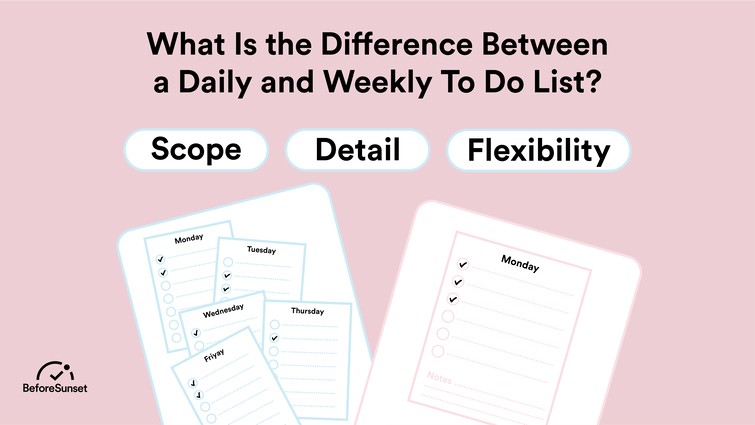
What Is the Difference Between a Daily and Weekly To Do List?
Consider the straightforward nature of a simple to-do list. The main difference between a daily and weekly to-do list is the timeframe they cover. A daily to-do list outlines all the daily tasks that need to be accomplished in a single day, while a printable weekly to-do list outlines the tasks that need to be accomplished over the course of a week.
Here are a few more differences between daily task lists and weekly to-do lists:
Scope: Daily to-do lists focus on short-term tasks, while weekly to-do lists include both short-term and longer-term tasks that can be accomplished over the course of several days.
Detail: Daily list of tasks tend to be more detailed and specific, with important tasks broken down into smaller, more manageable steps. Weekly to-do lists can be more general, with broader goals and objectives outlined for the week.
Flexibility: Daily to-do lists offer more flexibility and can be adjusted as needed throughout the day, while weekly to-do lists provide a more structured framework for the week ahead.
What is an editorial calendar template?
Content creators use an editorial calendar template to plan and organize their content production schedule. It is a calendar that specifies when various types of material, such as blog entries, videos, or social media updates, will be released. The template also includes information such as the topic of each piece of content, the author or creator in charge of its development, and any applicable deadlines.
Individuals and teams may utilize editorial calendars to guarantee that they are continuously delivering high-quality content that is aligned with their goals and objectives. They can assist to decrease last-minute content development, assure timely content publication, and give a clear perspective of the content creation process.
Editorial calendar templates come in a variety of formats, ranging from simple spreadsheets to more comprehensive project management software. Certain templates may additionally contain analytics tracking and social media scheduling functions. Finally, the precise template utilized will be determined by the needs and preferences of the individual or team who will be utilizing it.
5 Benefits of Using a Digital Weekly To-Do List Template
It could be difficult to keep up with everything when there are so many obligations and activities to manage. An electronic weekly task list template can help with this. You can remain on track and complete your tasks quickly and effectively with the aid of this helpful tool.
We'll examine five important advantages of utilizing a digital weekly to-do list template in this article. You'll learn how this straightforward yet effective tool may benefit your daily activities, from increased productivity to decreased stress. A digital weekly to-do list template may help you accomplish your objectives and make the most of each day, whether you're a student, a busy professional, or simply trying to get more done in less time.
You can also check out our blog post if you want to download daily to-do list template.
1. Create a new weekly to-do list in seconds
The ability to quickly construct a fresh weekly to-do list is one of the key advantages of utilizing a digital weekly to-do list template. You may create a fresh template with just a few clicks and begin adding chores and priorities for the coming week. You will save time and have a lower chance of forgetting key assignments or deadlines thanks to this simplified procedure.
The sections and categories that digital to-do list templates often provide make it simple to organize your chores in accordance with your goals and objectives. You have the freedom to modify your list in response to evolving conditions by adding new tasks and rearranging existing ones as necessary.
In order to make sure you don't forget anything crucial, many digital weekly to-do list templates let you create reminders and notifications for each job. When dealing with time-sensitive chores, including appointments or deadlines, this tool may be quite helpful.
In conclusion, utilizing a digital weekly to-do list template may help you quickly compile a thorough list of chores and priorities for the next week, saving you time and lowering the chance that you'll forget critical deadlines or projects.
2. See your entire week with a single glance
The ability to see your complete week at a single glance is a key advantage of using a digital weekly to-do list template. Digital templates frequently provide you a thorough perspective of your whole week, including all of your chores and priorities, in contrast to traditional priority tasks, which could simply indicate the tasks for a certain day or time.
With this aerial perspective, you may more efficiently arrange your week and assign chores a priority depending on their significance and due dates. Any possible conflicts or overlapping deadlines may be easily identified, making it simpler to reschedule or assign activities as necessary.
A lot of digital weekly to-do list templates also enable you color-code or categorize your chores, which makes it much simpler to understand at a glance which ones are most crucial, ongoing, and finished. This feature might be especially useful for people who want to see their chores and priorities clearly at a glance or who are visual learners.
3. Reorganize and restructure with a few, simple clicks
Digital templates make it simple to modify your list as necessary since you can add, remove, or rearrange activities fast, unlike a typical pen-and-paper to-do list.
You may easily drag and drop activities to a later day or time, for instance, if you discover that you've overcommitted and need to reschedule certain work for later in the week. Conversely, you may swiftly raise a task's priority on your list if you discover that it is more essential than you previously believed.
These features of adaptability and usability might be especially useful for those who constantly need to change their schedules or who must balance a number of conflicting objectives. You can quickly make adjustments with a digital weekly to-do list template instead of having to mark things off or remove them from a physical list.
4. Automate weekly work, and use its pages as an organizer
Automating your weekly work is a key advantage of employing a computerized weekly to-do list template. You may set up recurring activities or events, such weekly meetings or regular administrative work, on many digital templates so that they will automatically show up on your to-do list each week.
You may free up mental space and lower your chance of forgetting something vital by automating these repetitive actions. To make sure that you do these chores on time without continually checking your schedule or to-do list, you may also create reminders or notifications.
Certain digital weekly to-do list templates may also be integrated with other productivity tools, such project management software or calendar applications. You may further improve your process thanks to this connection, which eliminates the need for manual data entry or duplication of effort.
5. Connect tasks to larger objective
Using a digital weekly to-do list template also gives you the opportunity to link your actions to a more comprehensive aim or target. When you work on smaller, more routine chores, you may maintain motivation and concentrate on the big picture by connecting them to a larger goal or vision.
Several digital weekly to-do list templates let you prioritize chores or group them depending on how well they correspond with particular goals or objectives. For instance, you may use color coding to show which activities are associated with a specific project or labels to show which tasks are associated with a more general strategic aim.
You may use this tool to understand how each activity fits into the bigger picture, which makes it simpler to keep motivated and interested in your work. Making sure that you are always focusing on the most crucial goals, it may also help you spot areas where you might need to modify your priorities or emphasis.
Can a To Do List Help Me With Time Management?
A to-do list may be an efficient tool for time management. You may maintain organization and prioritize your chores by making a list of the things you need to do. You may ensure that you make progress on the things that matter most by prioritizing your chores and tackling the most crucial ones first.
A to-do list may also assist you in breaking down bigger projects into smaller, more manageable activities, which will make them simpler to take on and lessen feelings of overwhelm. You may spend your time more effectively and stop wasting it on low-priority or trivial chores if you have a clear list of what has to be done.
What Should I Put On My Daily To Do List?
The things you need to do each day in order to accomplish your objectives and keep on top of your daily obligations should be on your to-do list. This might include professional duties like finishing a project or replying to emails, as well as private tasks like working out or running errands.
Prioritize your duties and concentrate on the ones that are most urgent or vital. You may prevent feeling overwhelmed and maintain motivation by breaking down major jobs into smaller, more doable pieces.
Be honest with yourself about how much you can achieve in a day, and don't be afraid to change your to-do list as necessary to stay on course and advance toward your objectives.
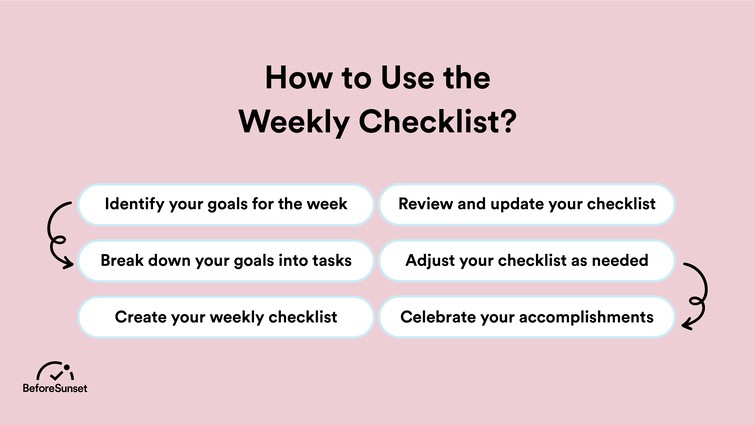
How to Use the Weekly Checklist?
You may keep organized and on track with your objectives and chores for the entire week, by using a weekly checklist. Following these guidelines can help you utilize a weekly checklist effectively:
Spend some time on Monday planning your week's agenda and the things you need to do. This will help you prioritize your duties and give you a clear notion of what has to be done.
Make a list of the things you need to accomplish based on your schedule and the responsibilities for the week. These might involve appointments, personal errands, work-related duties, and other commitments.
Decide which daily tasks are most crucial, then rank them in priority order. This will enable you to guarantee that you do the most important activities first.
Give each item on your to-do list a due date. This will enable you to stay on task and guarantee that you finish everything by the deadline.
Throughout the week, be sure to periodically assess your progress. You'll be able to maintain your motivation and make sure you're on pace to do everything on your checklist if you do this.
If you discover that you are lagging behind on your chores or if your schedule changes suddenly, make the required revisions to your checklist.
Set aside some time at the end of the week to reflect on your successes. You'll feel inspired and satisfied for all of your hard work if you accomplish this, which will keep you going.
How Can I Make a Weekly Planner?
While creating a weekly calendar, decide whether you want to start with a digital or paper planner. Following that, divide each day into time slots or segments for several categories such as work, personal responsibilities, and free time.
Create a list of everything you need to do this week, and then schedule each task with a specific day and time on your calendar. Prioritize your responsibilities and set appropriate timelines to ensure you can complete everything on time.
Next, monitor your planner during the week and make revisions as required, noting any changes or additions. If you utilize your weekly planner on a regular basis, it may help you stay organized and productive.
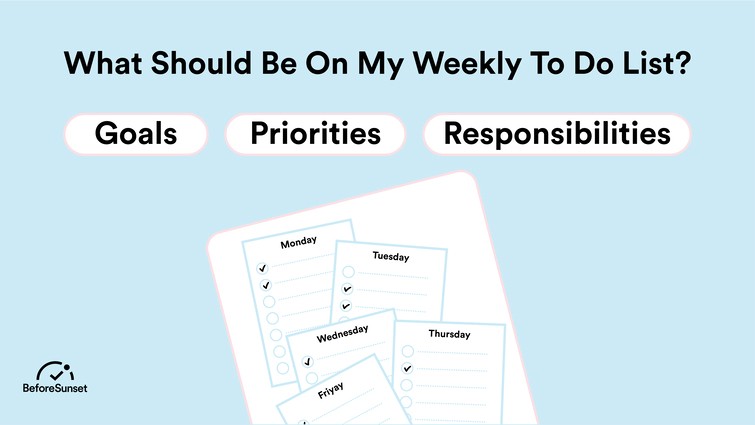
What should your goals be when preparing weekly to do list templates?
When preparing a weekly to-do list template, your goals should be to:
Prioritize tasks: Determine which tasks are the most important and need to be completed first. Prioritizing tasks can help you focus on what needs to be done and avoid getting overwhelmed by a long list of items.
Set achievable goals: Ensure that your to-do list includes realistic and achievable goals. Setting unrealistic goals can lead to frustration and a sense of failure if you are unable to complete them.
Break down larger tasks: If you have larger projects or tasks that need to be completed over several days, break them down into smaller, more manageable tasks. This can help you stay motivated and avoid feeling overwhelmed.
Allocate time for each task: Estimate how much time each task will take and allocate time in your schedule accordingly. This can help you stay on track and avoid overcommitting yourself.
Review progress regularly: Review your progress regularly throughout the week to ensure that you are on track to meet your goals. This can help you adjust your priorities and make any necessary changes to your to-do list.
What Should Be On My Weekly To Do List?
Your weekly to-do list should include all of the chores and goals that you need to complete in the next week. It should consist of a mix of personal and professional responsibilities that you must fulfill.
Completing projects, attending meetings, replying to emails, and making progress on long-term goals are examples of work-related duties. Grocery shopping, cleaning your home, exercising, spending time with family and friends, and pursuing hobbies or interests are examples of personal tasks.
To guarantee that you accomplish everything on time, prioritize your chores and establish realistic deadlines for each item on your to-do list. You can stay organized, motivated, and on track with your weekly objectives and chores by reviewing and revising your weekly to-do list on a frequent basis.
How Do I Manage My Weekly To-Do Lists?
Prioritizing your chores is the first step in efficiently managing your weekly to-do lists. Prioritize and prioritize your duties, and then allot your time appropriately. To make sure you can do everything on time, set precise hours to work on each assignment and give deadlines on a calendar or planner.
Mark each item off your list as you finish it to give yourself a sense of success and spur yourself on to the next one. Be adaptable and modify your to-do list if more chores or events crop up. Break a huge project or activity down into smaller, more manageable pieces, and set aside time each week to make work on it if it will take many days or weeks.
Lastly, take frequent pauses to prevent burnout and give yourself rewards when you finish projects or achieve objectives to keep yourself motivated. You may maintain organization, productivity, and focus on your objectives and duties by efficiently managing your weekly to-do lists.
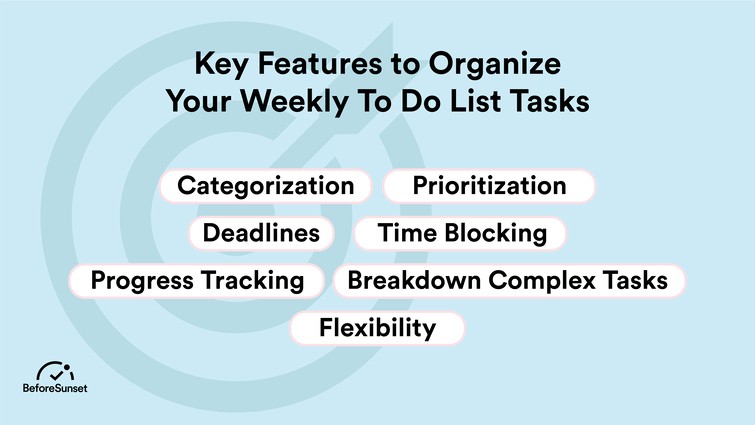
Key Features to Organize Your Weekly To Do List Tasks
I'm sure you have heard it before: life would be easier if you had a weekly to do list! Here are some of the key features to organize your weekly to do list:
Categorization
A weekly to-do list should categorize chores according to their kind or priority level since this will help people better manage their time and be more productive. People may quickly determine which jobs need to be attended to right now and which ones can wait or be outsourced by classifying them.
This enables them to concentrate their time and effort on the most important activities while making sure they do not miss any crucial details. Furthermore, categorization can assist people in dividing up bigger projects into smaller, more manageable jobs, making it simpler to monitor progress and keep on course to meet their objectives.
In the end, categorization is a crucial tool for efficient time management and may greatly increase a person's capacity to complete activities and meet their goals. If you get stuck on a particular task a to do list app can be of help.
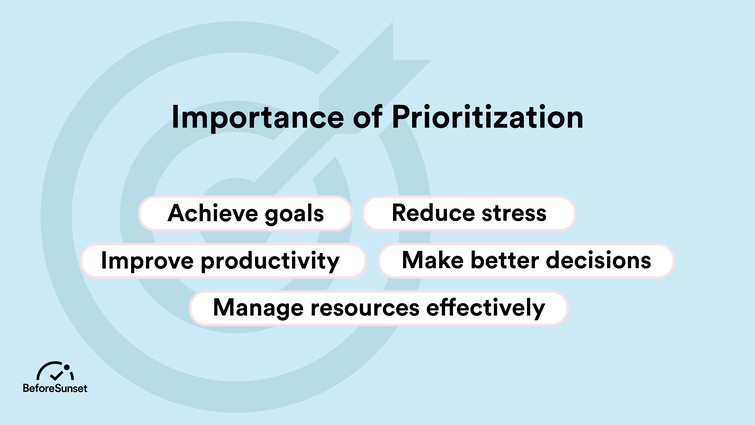
Prioritization
Prioritization is an important component of task management and weekly to do lists since it allows people to identify and focus on the most important and urgent tasks. Setting priorities allows people to keep their workload balanced while focusing on the things that are critical to meeting deadlines or accomplishing their goals.
As a consequence, individuals may operate more productively, effectively, and efficiently, and the tension and anxiety caused by a long list of responsibilities is decreased. Prioritizing can also help people avoid procrastination and preserve motivation by splitting major chores into smaller, more manageable ones and doing them one at a time.
Finally, creating priorities is an important component of effective time management and may help people make the most of their time, complete their daily chores, and achieve in both their personal and professional lives. That that people on a hourly schedule can greatly benefit from weekly planner If they prioritize tasks.
Deadlines
A weekly to-do list should include deadlines since they help people set clear goals and maintain focus on finishing chores on time. Setting deadlines may help people develop a feeling of urgency and responsibility, which can boost productivity and guarantee that projects are finished on time.
Deadlines can also assist people in prioritizing their workload by letting them know which chores should be finished first and which can wait until later. By giving a clear roadmap for what has to be done when and by whom, this can assist to minimize tension and worry.
This is especially beneficial when managing a lot of chores or complicated projects. In the end, deadlines are a crucial tool for efficient time management and may assist people in achieving their objectives and maintaining their progress. When you add tasks to your weekly list keep in mind the deadlines. It makes weekly planning a breeze.
Time blocking
A weekly to-do list for task management should include time blocking since it enables people to assign specified times to complete their chores, enhancing their productivity and efficiency. People can develop a regular routine that helps them stay focused on finishing their job on time by setting out certain timeframes for each task.
As it gives a clear roadmap for what needs to be done and when, this may be very beneficial for those who have a lot of tasks to accomplish or who are working on huge, complicated projects. All the tasks will be within weekly priorities as it is a part of the weekly planner.
By designating certain blocks of time for work and allowing time for breaks and rest periods to assist prevent burnout, time blocking may also help people avoid procrastination and distractions.

Progress tracking
Progress monitoring is an essential component of a weekly tasks. You may measure your progress toward your goals during the week and make any required modifications by integrating progress tracking.
This function aids with your motivation and attention while you attempt to finish your chores. Checkmarks may be placed next to each item on your list to indicate progress, or you can use a more intricate system like color-coding or grading your progress.
Frequently monitoring your progress also makes it easier to see any challenges or areas where extra time or resources are needed, ensuring that you stay on pace to meet your objectives.
Breakdown complex tasks
A weekly to-do list's capacity to divide challenging activities into smaller, more doable components is another crucial aspect. This is especially useful if you have a difficult or intimidating task at hand since breaking it down into manageable pieces can make it simpler to approach and accomplish.
You may also more effectively prioritize your workload and make sure that you are moving forward steadily toward your goals by dividing a difficult activity down into smaller subtasks. To do this, divide the activity into manageable chunks using bullet points or numbered lists.
When you complete each sub-task on your list, this function also helps you avoid procrastinating and makes you feel more successful.
Flexibility
An essential component of task lists is flexibility. The to-do list should be flexible enough to accommodate modifications as the week goes on. Because unexpected activities or events might occur in life, it is vital to reevaluate priorities and modify plans as necessary.
An individual may adjust to changing circumstances without feeling overburdened or pressured by including flexibility in a basic list. Also, being able to cross off accomplished things, even if they were not initially intended for that week, on a flexible to-do weekly task list template can help people keep their drive and sense of success.
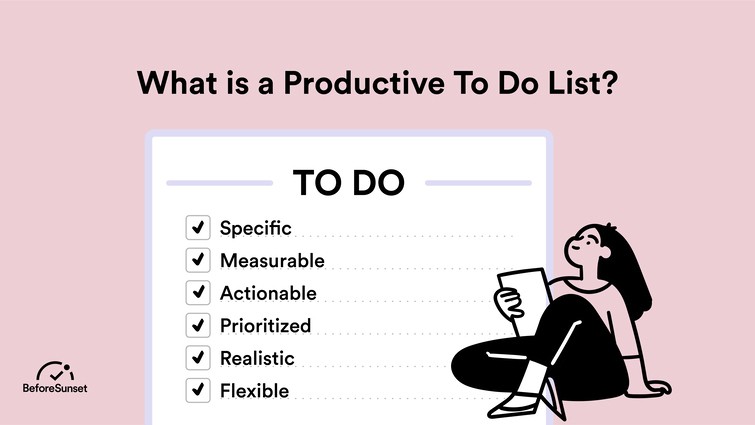
What Is a Productive To Do List?
A useful to-do list is a tool that aids in task organization and prioritization, which ultimately boosts productivity and achievement. A useful to-do list tasks per day should contain precise, doable activities that are in line with one's objectives and goals.
The activities should be divided into small, doable phases so that people may concentrate on the most crucial and urgent ones first. A successful to-do list should also be flexible and adaptive, enabling people to change their plans as necessary and prevent being overtaken by unforeseen activities or occurrences whether they are weekly tasks or monthly tasks.
An effective to-do list may also contain time estimates or deadlines for each activity to increase productivity even further. This creates a feeling of urgency and helps people remain on target. An effective to-do list should, in the end, act as a guide for boosting productivity while still managing to accomplish one's goals.
Should you make a to do list every day?
According to a survey conducted by Statista in 2021, around 65% of American adults use to-do lists to organize and manage their tasks. Depending on your own preferences and the nature of your work, you may or may not want to create a to-do list each day. Making a daily to-do list may help some individuals keep organized and on task, but it may be unneeded or even unpleasant for others.
Making a daily to-do list, however, might be a helpful tool if you have a lot of chores to perform each day or have a propensity to neglect crucial activities. You may use it to organize your work, maintain concentration on what has to get done, and feel accomplished as you cross things off as they are finished.
Making a daily to-do list should ultimately depend on what suits you and your working style the best. It could be worthwhile to include daily list-making in your routine if you find that it keeps you motivated and productive. An idea dump would be a good way to start even If they are bad ideas.
Print the Weekly To Do List Printable Checklist Template
Print our free printable weekly checklist template by clicking on the cover image! It is a helpful tool for organizing and managing tasks throughout the week. Have a structure for listing out specific tasks and customize the deadlines, priority levels, and other important information with this printable checklist template.
Or you could hop onto BeforeSunset AI which is basically a to do list app. BeforeSunset AI is a digital calendar and to do list software that leaves no need to a weekly planner template. All you have to do is sign up for free. There even is an AI to plan your day for you. There even is an AI to plan your day for you. You can integrate your Google Calendar into your calendar views.
Your busy schedule will no longer be busy with BeforeSunset AI.
Weekly Planning Made Effortless with BeforeSunset AI
Imagine having the ability to seamlessly access and manage your weekly to-do list directly within BeforeSunset AI's intuitive interface. With BeforeSunset AI's comprehensive features, including the weekly view of your calendar, you already have the foundation for efficient weekly planning at your fingertips. You can also download the mobile version of BeforeSunset AI and access to your to-do list in your pocket.
Integrated Weekly View: BeforeSunset AI offers users a convenient weekly view of their Google Calendar or Outlook Calendars, allowing them to visualize their upcoming tasks and events for the entire week at a glance. This integrated feature serves as the backbone for effective weekly planning by providing them with a weekly to do list view, enabling users to assess their workload, allocate time for tasks accordingly and eventually create the ideal daily schedule for themselves.
Dynamic Task Management: Within BeforeSunset AI's weekly view, users can seamlessly add, edit, and prioritize tasks directly on their calendar. By leveraging BeforeSunset AI's intuitive drag-and-drop functionality, users can effortlessly rearrange tasks, set deadlines, and allocate time slots for each task throughout the week.
Smart Scheduling: Using AI technology, BeforeSunset AI intelligently optimizes task scheduling based on user preferences and priorities. You can categorize your tasks according to their priority, such as high-priority tasks, medium-priority tasks, low-priority tasks, or no-priority tasks. As users input tasks into their weekly view, BeforeSunset AI analyzes available time slots and suggests optimal scheduling options, ensuring a balanced distribution of tasks and efficient time management.
Comprehensive Insights: By leveraging BeforeSunset AI's analytics features, users can gain valuable insights into their weekly productivity and performance. From tracking task completion rates to analyzing time spent on different activities, BeforeSunset AI provides users with actionable data to optimize their workflow and maximize productivity over time.
In essence, BeforeSunset AI empowers users to effortlessly manage their weekly to-do list and plan their week with precision and achieve their daily goals. By integrating task management seamlessly into the weekly view of their calendars, BeforeSunset AI streamlines the planning process, enhances productivity, and helps users stay organized and focused on their goals.


